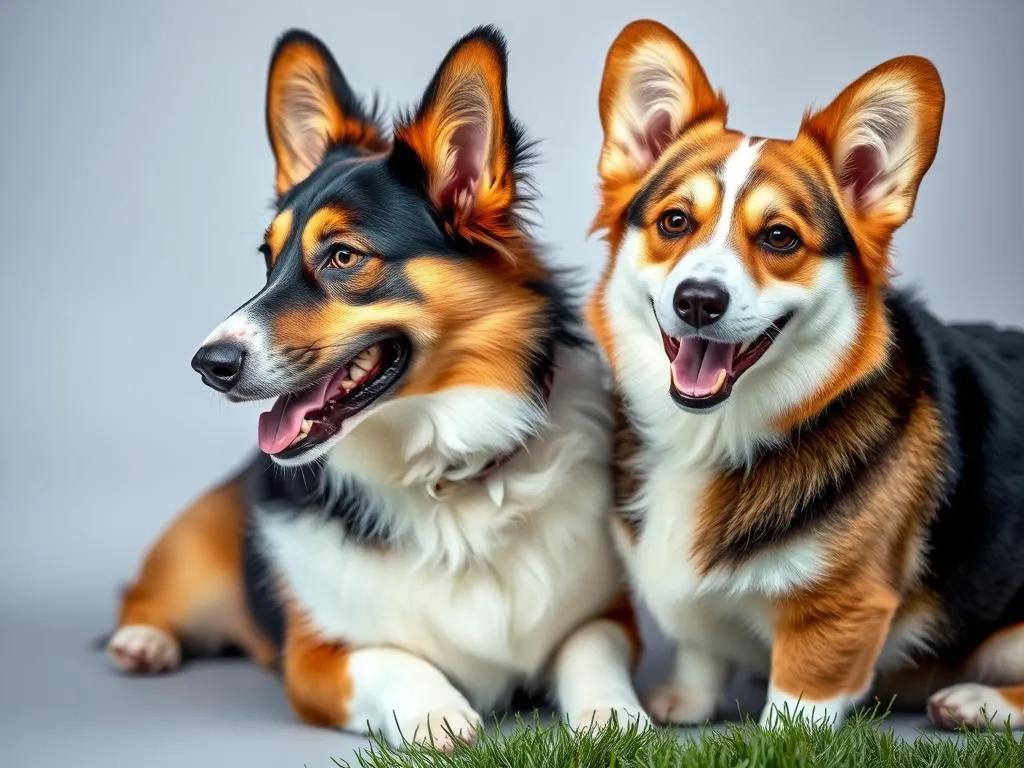
Introduction
Corgis have surged in popularity over the past few decades, charming dog lovers with their adorable looks and playful personalities. Among the most recognized breeds are the Cardigan Welsh Corgi and the Pembroke Welsh Corgi. While they may appear similar at first glance, understanding the differences between these two distinct breeds is crucial for potential owners. From their historical roots to their physical characteristics, temperament, and even health considerations, this article will delve into the nuances of Cardigan Welsh Corgi vs Pembroke Welsh Corgi, helping you make an informed decision about which breed may be the best fit for your lifestyle.
Historical Background
Origins of the Cardigan Welsh Corgi
The Cardigan Welsh Corgi is one of the oldest herding breeds, with origins tracing back over 3,000 years to the Celts who settled in Wales. Historical records suggest that these dogs were brought to Wales by the Celts from Central Europe, where they were initially used for herding cattle and guarding farms. The breed’s name “Corgi” translates to “dwarf dog” in Welsh, aptly describing their stature.
Throughout history, Cardigans have played a significant role in Welsh culture, often depicted in folklore and associated with local legends. They gained recognition in the early 20th century, eventually being acknowledged by kennel clubs worldwide. Their loyal nature and intelligence have made them beloved companions and working dogs alike.
Origins of the Pembroke Welsh Corgi
In contrast, the Pembroke Welsh Corgi has a more recent history, believed to have been brought to Pembrokeshire, Wales, by Flemish weavers in the 10th century. While they share a common ancestor with Cardigans, Pembrokes were developed as a separate breed, primarily serving as herding dogs. Their popularity skyrocketed when they became associated with the British royal family, particularly Queen Elizabeth II, who has owned more than 30 Pembroke Corgis throughout her reign.
This royal connection has undoubtedly contributed to the breed’s popularity, leading to increased recognition and demand in recent years. Both breeds have their unique charm, but the Pembroke’s ties to royalty have given them an iconic status.
Key Differences in History
The historical roles of Cardigan Welsh Corgis and Pembroke Welsh Corgis have significantly shaped their characteristics. Cardigans were bred for versatility in herding and guarding, resulting in a sturdier build suited for various tasks. Pembrokes, on the other hand, were cultivated to be more agile and quick, reflecting their herding duties.
Culturally, both breeds hold significance in Welsh history, but the Pembroke’s association with the monarchy has elevated its profile internationally. Understanding these historical contexts provides insight into their respective temperaments and physical attributes.
Physical Characteristics
Size and Build
In terms of size, both breeds are relatively similar but have distinct differences. The Cardigan Welsh Corgi typically stands between 10.5 to 12.5 inches tall at the shoulder and weighs about 25 to 38 pounds. They sport a more robust and heavier build, often with a longer body and a deeper chest.
Conversely, the Pembroke Welsh Corgi is slightly smaller, standing around 10 to 12 inches tall and weighing between 25 to 30 pounds. Their build is generally more refined and agile, which reflects their herding style. This difference in size and build can affect their agility and endurance during activities.
Coat and Color
Both breeds have double coats that shed seasonally, but their coat types and colors vary. Cardigan Welsh Corgis possess a medium-length coat that is dense and weather-resistant. They come in a variety of colors, including brindle, black, blue merle, and red.
On the other hand, Pembroke Welsh Corgis typically have a slightly shorter coat, which is also dense but may not be as weather-resistant as that of the Cardigan. Pembrokes are primarily seen in colors like red, sable, fawn, and tri-color (black, white, and tan).
Distinctive Features
One of the most recognizable differences between the two breeds is their tails. Cardigan Welsh Corgis have long, bushy tails, while Pembroke Welsh Corgis usually have docked tails, giving them a more distinctive appearance. This tail difference is not just cosmetic; it often reflects their herding styles. Cardigans use their tails as balance while herding, whereas Pembrokes, with their shorter tails, are designed for speed and agility.
Additionally, the ear shapes differ: Cardigans often have rounded ears, while Pembrokes feature more pointed ears. These physical traits are key identifiers for breed enthusiasts and can help potential owners distinguish between the two.
Temperament and Behavior
General Temperament
Both breeds are known for their cheerful and affectionate nature. Cardigan Welsh Corgis tend to be more laid-back and can exhibit a calm demeanor, making them excellent companions for families and individuals alike. They are known for their loyalty and protective instincts, often forming strong bonds with their owners.
In contrast, Pembroke Welsh Corgis are generally more energetic and playful. They have a spirited personality, which can sometimes lead to a more mischievous behavior. Pembrokes are often eager to please and can be quite sociable, thriving in active environments.
Trainability and Intelligence
Both breeds are highly intelligent and trainable, but their approach to training can differ. Cardigan Welsh Corgis may exhibit a slightly independent streak, which can make them a bit more challenging to train. However, with consistent and positive reinforcement methods, they respond very well to training.
On the other hand, Pembroke Welsh Corgis are often quicker to pick up commands and enjoy engaging in training sessions. Their eagerness to please their owners makes them more responsive, which can be beneficial for first-time dog owners.
Socialization and Interaction
Socialization is crucial for both breeds, although their social interactions may vary. Cardigan Welsh Corgis can be more reserved around strangers and other pets, requiring gradual socialization to feel comfortable. They are typically good with children and can adapt well to family life.
In contrast, Pembroke Welsh Corgis are known for their friendly and outgoing nature. They generally get along well with other dogs and pets, making them ideal for multi-pet households. Their adaptable nature allows them to thrive in various environments, whether in a bustling home or a quieter setting.
Health Considerations
Common Health Issues
Both breeds share some predisposed health issues, primarily related to their unique physical structures. Cardigan Welsh Corgis can be prone to hip dysplasia, degenerative myelopathy, and certain eye disorders. Their lifespan typically ranges from 12 to 15 years.
Pembroke Welsh Corgis also face similar health concerns, including hip dysplasia, eye conditions, and obesity. They have a slightly shorter lifespan, averaging around 12 to 14 years. Regular veterinary check-ups can help identify and address potential health issues early on.
Preventive Care
Preventive care is vital for both breeds to ensure a long and healthy life. Regular vet visits for vaccinations, dental care, and health screenings are essential. Corgis should also undergo routine check-ups to monitor for common genetic issues, especially those related to their hips and eyes.
Nutrition and Diet
Dietary needs can vary between the two breeds, though both require high-quality dog food appropriate for their age, size, and activity level. Cardigan Welsh Corgis may have a slightly higher caloric requirement due to their larger size, while Pembroke Welsh Corgis should be monitored closely to prevent obesity, as their playful nature can lead to overeating.
Both breeds benefit from a balanced diet rich in protein, healthy fats, and essential vitamins. Consulting with a veterinarian to establish a suitable diet plan is always advisable.
Lifestyle Compatibility
Ideal Living Conditions
When considering Cardigan Welsh Corgi vs Pembroke Welsh Corgi, it’s essential to evaluate your living conditions. Both breeds adapt well to various environments, but their ideal settings may differ.
Cardigan Welsh Corgis thrive in homes with ample space to roam and a secure yard for exercise. They enjoy outdoor activities and require regular playtime to maintain their health and happiness.
Pembroke Welsh Corgis, while they also enjoy outdoor space, can adapt better to apartment living if they receive sufficient daily exercise. Their energy levels require regular walks and play sessions to keep them mentally and physically stimulated.
Family Compatibility
Both breeds make excellent family pets, but their compatibility can vary based on individual temperaments. Cardigan Welsh Corgis are generally more cautious and may take time to warm up to children or other pets. They require gentle introductions and supervision during play.
In contrast, Pembroke Welsh Corgis are often more playful and tolerant, making them great companions for children. Their sociable nature allows them to integrate well into a family dynamic, fostering strong bonds with their human companions.
Activity Level and Exercise Requirements
Both breeds require regular exercise to maintain their health and prevent behavioral issues. Cardigan Welsh Corgis benefit from at least 30 to 60 minutes of daily exercise, including walks, play sessions, and mental stimulation.
Pembroke Welsh Corgis, being a bit more energetic, may require slightly more exercise, ranging from 45 minutes to an hour each day. Engaging activities such as agility training, fetch, and interactive games can help burn off excess energy and keep them entertained.
Grooming Requirements
Coat Maintenance
Grooming needs for both breeds are relatively similar, though the Cardigan Welsh Corgi’s longer coat may require more frequent brushing, especially during shedding seasons. A thorough brushing at least once a week helps reduce loose hair and keeps their coat healthy.
Pembroke Welsh Corgis, with their shorter coats, require less frequent grooming, but they still benefit from regular brushing to manage shedding. Both breeds are moderate shedders, so establishing a grooming routine can help keep your home hair-free.
Nail Care and Ear Cleaning
Regular nail care and ear cleaning are essential for both breeds. Maintaining nail length is crucial for their comfort and mobility. Regular walks on hard surfaces can help wear down nails naturally, but additional trimming may be necessary.
Ear cleaning should be part of your grooming routine, as both breeds are prone to ear infections. Checking their ears for dirt or wax buildup and cleaning them with a vet-recommended solution can help maintain their ear health.
Bathing and Skin Care
Bathing frequency can vary based on each dog’s activity level and skin condition. Generally, both breeds should be bathed every 2 to 3 months or as needed. Using a gentle, dog-specific shampoo helps maintain their coat health without stripping natural oils.
Some dogs may have skin sensitivities, so it’s essential to monitor for any signs of irritation or allergies. Consulting a veterinarian for skin care advice can help ensure your Corgi remains comfortable and healthy.
Conclusion
In summary, both the Cardigan Welsh Corgi and the Pembroke Welsh Corgi present unique characteristics, temperaments, and grooming needs that can suit different lifestyles. Cardigans tend to be more laid-back and sturdy, while Pembrokes are energetic and playful.
Choosing between the two breeds should be based on your personal preferences, living conditions, and the type of companionship you seek. Whether you find yourself drawn to the regal charm of the Pembroke or the loyal nature of the Cardigan, both breeds promise to bring joy and companionship into your life. Potential owners should consider their lifestyle, activity level, and family dynamics when making a choice, ensuring a harmonious relationship with their new furry friends.









